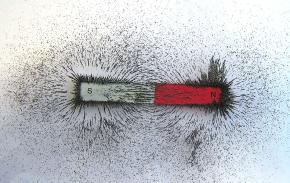Title
Weird Science: EarthŌĆÖs Magnetic Field
NGSS Crosscutting Concepts
NGSS Disciplinary Core Ideas
SF Fig. 7.5. The orientation of iron fillings makes the magnetic field lines around a bar magnet visible. Iron is a magnetic material that is either repelled or attracted to the two poles of the bar magnet.
Image courtesy of Dr. Dayna Mason, Flickr, modified by Narrissa Spies
A magnetic field is the three-dimensional area around a magnet in which the magnet exerts force on other objects. The invisible magnetic field of a simple bar magnet can be visualized by placing iron filings around it (SF Fig. 7.5). The magnet exerts force on the iron filings causing them to move and align with the magnetŌĆÖs magnetic field lines. Every magnet has a north pole (often colored red and labeled ŌĆ£NŌĆØ) and a south pole (often colored blue and labeled ŌĆ£SŌĆØ). Opposite magnetic poles are attracted to each other. For example, the north pole of one magnet would be attracted to the south pole of a second magnet.
SF Fig. 7.6. Diagram showing lines representing EarthŌĆÖs magnetic field lines. Compass needles orient themselves along magnetic field lines. Note that the south pole of the earthŌĆÖs magnetic field points toward the Arctic Circle.
Earth has a strong magnetic field (SF Fig. 7.6) with magnetic poles. EarthŌĆÖs magnetic field originates it its core, which is primarily made of the magnetic material iron. EarthŌĆÖs magnetic field is generated and maintained by the fluid outer core moving around the solid inner core to induce electric currents. These electric currents generate magnetic fields perpendicular to the flow of electric charge. This process is described by the dynamo theory and it applies to many other celestial bodies.
Wayfinders have long been able to navigate from place to place with the use of simple magnetic compasses. Compass needles orient themselves towards the magnetic poles of Earth. The so-called ŌĆ£North PoleŌĆØ in the Arctic Circle is actually the south pole of EarthŌĆÖs magnetic field. It is called the North Pole because the north pole of compass needles point toward it. Similarly, the south pole of a magnetic compass needle is attracted to the north pole of EarthŌĆÖs magnetic field found off the coast of Antarctica. The earthŌĆÖs magnetic poles are not the same as the earthŌĆÖs geographical poles.
Question Set
- Use your own words to define the following terms:
- magnetic field
- magnetic pole
- If you were standing in Canada, the red tip of your magnetic compass needle (labeled ŌĆ£NŌĆØ) would point towards the Arctic Circle. How would this affect the way you navigate by compass in this part of the world?
- If you were standing in Australia, in what direction would the red ŌĆ£NŌĆØ tip of your compass needle point? Explain your reasoning using the terms ŌĆ£magnetic fieldŌĆØ and ŌĆ£magnetic pole.ŌĆØ
- EarthŌĆÖs magnetic field is not exactly at the geographic north pole. Why do you think people still use a simple magnetic compass?
- Investigate how EarthŌĆÖs magnetic field varies at different locations on the planetŌĆÖs surface.









